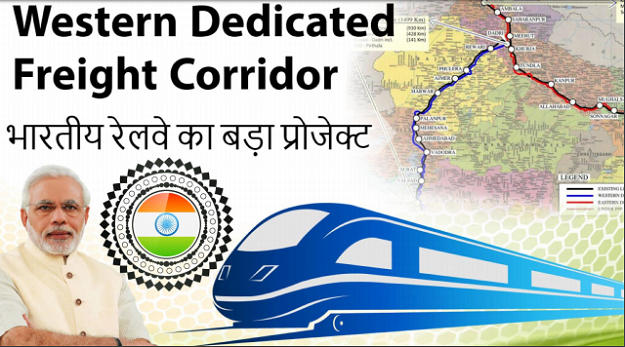Table of Contents
BASICS
•After 165 years of its birth, Indian Railways is set to get its first publicly-owned dedicated corridor for freight trains on August 15, when the country will be celebrating its 72nd Independence Day. (2018)
• This will be the last Independence Day speech by PM Modi in this term and is supposed to set the tone for the upcoming national elections.
NOTES
•Prime Minister Narendra Modi is likely to dedicate to the nation a 190-km railway line between Dadri in Uttar Pradesh and Phulera in Rajasthan, which fall under the Western Dedicated Freight Corridor (WDFC).

BASICS
The total cost estimate for the two dedicated freight corridors – eastern and western – is Rs 81,459 crore with the Japan International Cooperation Agency providing over Rs 38,000 crore as loan for the WDFC. The Railways plans to commission both the corridors by April 2020.
WESTERN DEDICATED FREIGHT CORRIDORS:
The 1,504-km-long route — from JNPT to Dadri via Vadodara-Ahmedabad- Palanpur-Phulera- Rewari —Western DFC will pass through Haryana, Rajasthan, Gujarat, Maharashtra and Uttar Pradesh. It is proposed to join the Eastern Corridor at Dadri.

DEDICATED FREIGHT CORRIDOR CORPORATION OF INDIA
•The DFCCIL is a corporation run by the Ministry of Railways (India) to undertake planning & development, mobilisation of financial resources and construction, maintenance and operation of the Dedicated Freight Corridors.
•DFCC has been registered as a company under the Companies Act 1956 on 30 October 2006. WHAT ARE DEDICATED FREIGHT CORRIDORS (DFC)? These are freight-only railway lines to move goods between industrial heartlands in the North and ports on the Eastern and Western coasts. The dedicated freight-only lines are being built along the four key transportation routes – known as the Golden Quadrilateral and connecting Delhi, Mumbai, Chennai, Howrah and its two diagonals (Delhi – Chennai and Mumbai – Howrah).
WHY DO WE NEED DFCS?
• The Indian rail network is one of the most elaborate rail networks in the world. It spans little over 66,000 route Km and due to this elaborate network and trains that ply on the network there is complexity in both passenger and freight operations.
• The complexity of the passenger business can be gauged from the fact that daily more than 2.3 crore passengers are carried on the railway network between roughly 8500 stations.
NOTES
• The freight side is similarly complex with daily over 30 lakh ton of freight being transported making it the fourth largest carrier of freight globally. • Coal accounts for a bulk of originating tonnage on the freight side with over 90% of coal being moved in the country through the India’s railway network. The current rail operations are faced with even more complexity as Indian Railways essentially runs mixed traffic across the length and breadth of its elaborate network.
NEED FOR DEDICATED FREIGHT CORRIDORS (DFCS)
• India’s four metropolitan cities of Delhi, Mumbai, Chennai and Howrah near Kolkata are linked in the form of a Golden Quadrilateral. The Golden Quadrilateral along with its two diagonals (Delhi-Chennai and Mumbai-Howrah), together carry little over half of passenger traffic and account for close to 58% of freight traffic on the Indian Railways.
• The existing trunk routes of Howrah-Delhi on the eastern corridor and Mumbai-Delhi on the western corridor are highly saturated, with the line capacity utilization of more than 100 and varying between 115% and 150%. A rail route is considered congested if capacity utilization exceeds 80%.
SALIENT FEATURES
•DFCs will adopt world class and state-of-the-art technology. Modification of basic design features like increasing the height and width of rakes, more than doubling the train length from 0.7 Km to 1.5 Km, more than doubling the train load from 5,000 ton to 13,000 ton, and increasing average speed to almost 3 times the existing speed will bring a monumental change in movement of freight along the railway network.
• Uttar Pradesh to benefit most from dedicated freight corridor
• It would pass through 7 states, 61 districts and more than 1000 villages involving 10589 hectares land and over 3,04,603 PAPs (people affected by the project).
• The states to be benefitted are Uttar Pradesh (1077kms), Bihar (100kms), Punjab (88kms), Haryana (248 kms), Rajasthan (567 kms), Gujarat (565 kms), Maharashtra (177kms).
• A whopping 38% of the total project was in Uttar Pradesh and benefit the state most, said Mittal.


PROBLEMS
•Slow speed
•The targeted completion of the project was 2016- 17, shifted to the year-end of 2017-18 and now has finally been set at April 2020.
FUNDING
•While Japan International Cooperation Agency is providing loan of Rs 387.22 billion for the Western India project, the Eastern DFC (Mughalsarai-AllahabadKanpur-Khurja-Dadri- & Khurja-Ludhiana) is being funded by the World Bank through a loan of $2.360 billion.






















 WhatsApp
WhatsApp